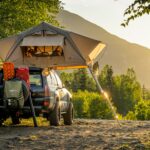
Camping Canopy Setup Mistakes
One of the worst things that can ruin a camping trip is a tent collapsing in the middle of the night. I have helped many campers with their shelter issues, and I have seen the same mistakes happen all too often. These are not just minor annoyances; they are potentially dangerous situations that expose you to the elements.
The good news? Most tent setup mistakes are completely avoidable. Today, I’ll look at the seven most common mistakes people make when setting up camping tents and explain how to avoid them.
Mistake #1: Choosing the Wrong Location
This is important. I’ve seen experienced campers make this mistake, and it almost always ends in disaster. The location of your canopy affects everything from stability to safety to comfort.
The problem is that too many campers choose looks over functionality. They tend to congregate in valleys (water runoff issues), on hillsides (higher winds), or under trees (water and falling limbs).
The answer is to find an area with adequate drainage and natural shelter. The best places have:
Natural windbreaks, such as rocks or thick vegetation
Slopes and slightly elevated ground away from your setup
Stable, level terrain that won’t turn into a swamp
No overhanging branches or loose rocks
Pro tip: When setting up, take a tour of your possible location. It will also affect your canopy if there are severe winds. Even if it means giving up that fantastic view, go to a more protected location.
Mistake #2: Ignoring Wind Direction and Weather Patterns
Despite the fact that wind is your canopy’s biggest enemy, many campers overlook it. More camping gear has been ruined by this mistake than any other. The problem was setting up without considering the upcoming weather or prevailing winds. Even heavy-duty canopies can tear due to the sail effect created when campers position the widest side of their canopy perpendicular to the wind.
Solution: Always check the weather forecast before setting up. Set up your canopy so that the wind will affect the narrowest profile first. If possible, angle it around the building instead of directly hitting it. Advanced method: Apply the “wind shadow” theory. Position your canopy behind organic windbreaks but allow enough space to block turbulence from downdrafts.
Mistake #3: Inadequate Ground Anchoring
This is where the majority of novices make terrible mistakes. They use the simple anchors included with their canopy and then question why, in moderate winds, their shelter turns into a flying projectile.
The issue is either using too few anchor points, too few stakes for the ground, or improper spacing. In soft soil, standard tent stakes perform admirably, but in rocky, sandy, or freezing terrain, they fall flat.
The answer is to invest in a range of stakes under various circumstances:
- Stakes made of sturdy steel for rocky terrain
- Deadman anchors or sand stakes for loose soil
- Stakes made of snow for winter camping
- Spiral stakes under typical circumstances
Fundamental Guideline: For any canopy greater than 8 by 8 feet, use a minimum of 8 anchor points. For optimal holding power, stake guy-lines at 45-degree angles and evenly spread them around the perimeter.
Mistake #4: Improper Frame Assembly
Although canopy frames may appear straightforward, there are two correct and incorrect ways to put them together. If you do it incorrectly, your joints will become weak and break under pressure.
The issue is hurrying through the assembling process without making sure all the connections are correct. Typical problems include:
Poles not fully inserted into fittings
Joint misalignment that results in stress areas
Before the frame is completely put together, the fabric is tightened.
The Fix: Adhere precisely to the manufacturer’s assembly instructions. The majority of canopies ought to be put together like follows:
Arrange every part and check for damage.
Complete the frame assembly before securing the fabric.
Make sure every connection is locked and fully seated.
Attach the fabric in a methodical manner, beginning in one corner.
Apply strain evenly and gradually.
Important Check: Make sure all joints are linked correctly before lifting the canopy. The first major stress will cause a loose joint to fail.
| Coleman Skydome Camping Tent with Screened Porch | Know more |
| UNP Tents 6 Person Waterproof Windproof Easy Setup | Know more |
| Londtren 4 Person Easy Pop Up Tent Waterproof Automatic Setup | Know more |
| KTT Extra Large Tent 12 Person,2 Bay-Windows,Family Cabin | Know more |
| FanttikOutdoor Camping Tent 4/6/8/10 Person Instant Cabin Tent Setup | Know more |
Mistake #5: Overtightening or under tightening the Fabric
Similar to the Goldilocks principle, fabric tension must be precisely balanced. If your canopy is too slack, the wind will cause it to flap destructively. If it’s too tight, stress points will be created, which might result in tears and frame failure.
The issue is that most individuals either leave the cloth free to prevent damage or tighten everything as much as they can because they believe that stronger is better. Both strategies lead to issues.
The Fix: Strive for tension that is solid but not stiff. The fabric should have enough give to withstand wind gusts and thermal expansion but still be taut enough to avoid flapping. This is how to check for appropriate tension:
Use your palm to press the fabric; it should yield a little but bounce back.
Look for any loose spots or overly strained corners as you move over the canopy.
Make minor tweaks to several areas at a time rather than making significant changes to just one.
Mistake #6: Forgetting About Drainage and Water Management
Water is sneaky. Even when you believe you have everything figured out, it still manages to cause issues. Your campground may flood, your canopy may collapse, or hazardous conditions may arise due to inadequate water management.
The issue is that the movement of water during rain is not taken into consideration. Typical problems include:
Installing in organic drainage channels
Using incorrect fabric tension to create water collecting points
Not establishing runoff channels around the property
The Fix: Consider it like water. When it strikes your canopy, where will it go? Make a plan for it:
- Make sure the site slopes away from the setup’s center.
- Make little drainage channels all around the edge of your canopy.
- Modify the tension of the fabric to promote water runoff instead of pooling.
- Think about the canopy’s angle; even a small incline aids in water drainage.
Emergency Method: If you’re stuck in a severe downpour with pooling problems, raise one corner of the cloth a little with a camping pole or stick to make a drainage point.
Mistake #7: Poor Guy-Line Management
Although they are your canopy’s insurance policy, guy-lines are sometimes the most overlooked setup component. Ineffective guy-line management compromises the stability of your canopy and poses safety risks.
The issue: Putting insufficient guy-lines, positioning them incorrectly, or making your campsite a trip hazard. Guy-lines are frequently placed up improperly or completely ignored by campers.
The Fix: Consider guy-lines to be crucial elements:
Utilize a luminous guy-line cord to improve visibility at night.
Make 45-degree angles between the corners of the canopy and the anchor points.
Keep the tension just right—tight enough to support, but not too tight that it prevents some mobility.
Instead of using static knots, use tensioners that can be adjusted.
Use reflective markers or bright flagging tape to designate guy-lines.
Safety first: Don’t be careless with guy-lines at night. In the dark, a loose guy-line is a surefire way to break your ankle.
Additional Pro Tips for Canopy Setup Success
Start by practicing at home.
Before you go, set up your canopy in your backyard. Finding any damaged parts or missing parts while you can still remedy the issue is more important than simply mastering the procedure.
Make a Checklist for Setup
Every stage of your setup procedure should be documented. This keeps you from forgetting important actions when you’re exhausted or under difficult circumstances.
Keep backup gear on hand.
Always bring basic repair supplies, guy-line rope, and extra stakes. In comparison to the security they offer, their weight is negligible.
Recognize Your Canopy
When something is amiss, you will be alerted by your canopy. Recognize the warning indicators, which include odd noises, obvious tension on the frame or cloth, or shifts in stability.
When Things Go Wrong: Quick Fixes
Even with proper setup, mistakes can happen. Here are some quick fixes for common mistakes:
Stake Break: Attach a large rock to a sturdy tree or use a deadman anchor.
Tear in fabric: For short-term fixes, duct tape works well; however, for long-term fixes, use an appropriate patching material.
A Bent Frame Avoid trying to straighten bent metal; instead, repair the damaged area or find a workaround.
Conclusion
With proper setup methods and attention to detail, most camping canopy accidents can be avoided. 90% of the canopy failures I’ve seen over the years are caused by the mistakes I’ve outlined here.
Keep in mind that your tent serves as a shelter to keep you safe from natural calamities. The purpose of taking the time to properly set things up is safety, not convenience. A well-assembled tent will shield you from storms that could ruin a hastily put up tent.
Take a few additional minutes to steer clear of these typical blunders the next time you set up camp. When you remain comfortable and dry while others cope with damaged shelters and wet equipment, your future self will appreciate it.
Knowing how to make the most of what you have is more important for effective camping than owning the priciest equipment. Once you understand these setup concepts, you’ll be prepared to handle any challenge nature presents.






